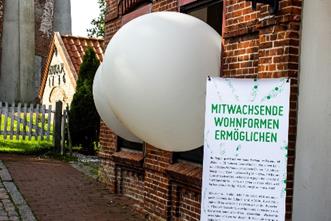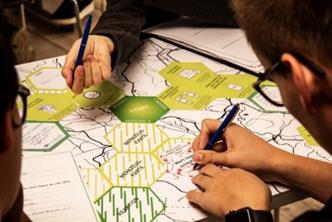

What will life in rural areas look like in the future? What needs do people have, and how we support policymakers in addressing these needs? Scientists from Fraunhofer INT work on answering these questions in “Widening Horizons – Changing Perspectives”, a project which is funded by the Federal Ministry for Education and Research. Running from March 2017 to February 2020, this cooperation project is being coordinated by the Fraunhofer IAO’s Center for Responsible Research and Innovation (CeRRI). Other project partners are the Humboldt University Berlin, the Institute for Social Innovation e.V. (ISInova) and the Leibniz Geographic Institute (IfL).
By focusing on rural areas as active innovation drivers, new areas of research emerge, as well as new measures and strategies for successfully implementing technology in these areas.
The Fraunhofer INT team focused on these questions:
Which technologies can help in making the future scenarios come true?
And on this basis, how can new innovation strategies and processes be derived for rural areas?
New Technologies for Rural Areas
As a first step, Fraunhofer CeRRI ran a workshop with pioneers and visionaries to generate future scenarios that people in rural areas would wish for. Fraunhofer INT used these images of the future to identify relevant technologies that can help translate these scenarios into reality. INT identified several tecnologies which were subsequently prioritized with the help of interviews with technology experts from the Fraunhofer-Gesellschaft.
The prioritized technology options were then used to prepare workshops in three different model regions throughout Germany. To make a possible a playful approach to the technologies for all the participants, a cooperative, game-based format was developed to identify relevant technologys for the residents of rural areas – based on their concrete needs.
Workshop Schedule in the Model Regions
The workshops were held in three selected regions throughout Germany: Ilzer Land in Bavaria, Eiderstedt on the North Sea coast of Schleswig-Holstein, and Werra-Meissner District in North Hesse. The interactive, playful way allowed the participants to immerse into the future scenarios within their familiar environments.. Design-based methods were used to support the process, which allowed a region’s future prospects to take account of demands on innovation and technological development.
On Day 1, workshop participants took part inthree future task courses in the region concerned, with each course having four thematic areas. This method made the courses tangible for the participants, something that theycould negotiate their way through. Using “speculative artifacts”, participants explored and experienced the visions in their everyday environments (see Fig. 1). Then, with the help of a questionnaire and group presentations,
they were able to reflect in what they experienced. The three future scenarios dealt with a variety of topics, from adaptive housing forms to new learning and educational cultures, from rethought logistics through to innovative working models. In each area, different future solutions werde presented to the participants:; they discussed various ideas like intelligent administration, the exploitation of regional values, or new community locations, for example.
On Day 2, the participants were split into small groups for a “futures game”, where they had the time to reflect their favorite ideas from the first day. Together they picked out topics from the previous day, and used these topics as missions for the game. With these missions, the teams were given the opportunity to answers various questions always keeping in mind the main question: How do we want our local life in our region to look like in the year 2034? The playful approach enabledthe participants to be designers of their own future in their own region (see Fig. 2). The participants’ individual thoughts and needs had a special impact in playfully fomulating what was locally needed to achieve a successful conclusion of the mission. The teams contemplated concrete requirements and ideas for innovations, and they developed their own strategic visions of their region’s future. So the game let the participants identify what steps could be taken by themselves, and they discussed and identified solutions that they found to be missing.
The workshops ended with the each team presenting their visions of the future in a brief role play. Using specially-made props and a good portion of humor, they presented their ideas to the other participants and to representatives from politics and society in general.
As a next step, the workshops will be evaluated so that tailor-made measures and technologies can be identified and derived for rural regions. Then result will be the basis for Fraunhofer INT to compose a list of technologies that meet the the actual articulated needs in rural areas forthe year 2034. Following that, expert teams will identify the critical technologies needed for rural areas in Germany. Finally, recommendations and measures will be derived forpolitical decision-makers, regional developers, research strategists and managers in non-university research institutions. This is designed with the project’s original goal in mind: an improved technology transfer between urban and rural areas, and the idea to enable and support rural areas in being drivers of innovation.
 Fraunhofer Institute for Technological Trend Analysis INT
Fraunhofer Institute for Technological Trend Analysis INT